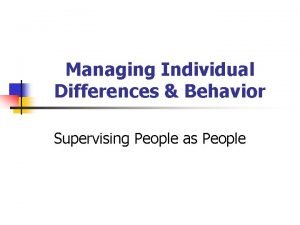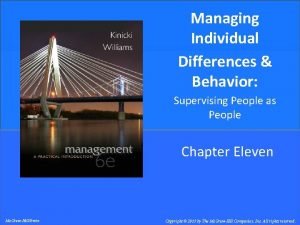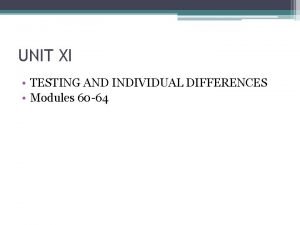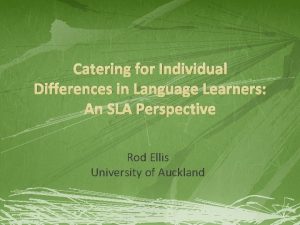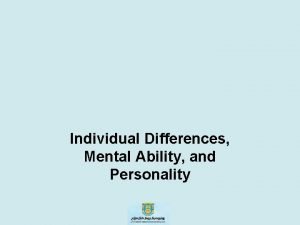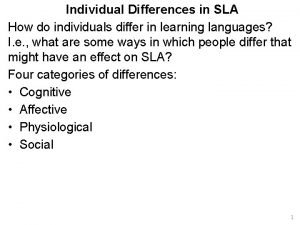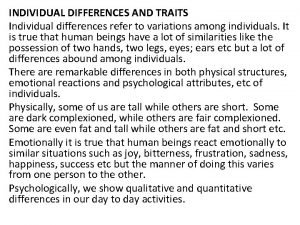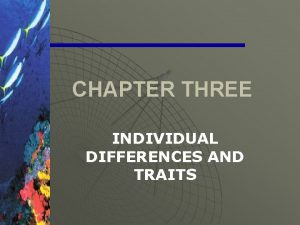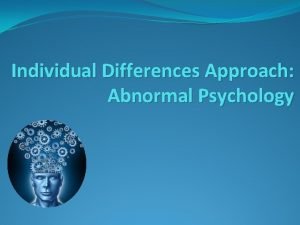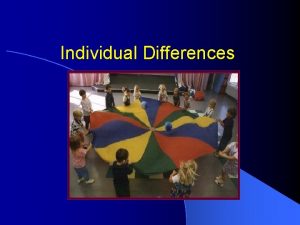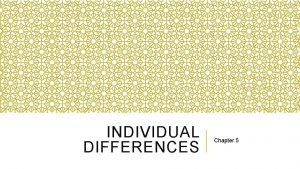The Nature and Measurement of Individual Differences in








- Slides: 8


The Nature and Measurement of Individual Differences in Epistemic Curiosity (EC): An innate motive that underlies knowledge-seeking, problem-solving and intellectual development. Research on individual differences in EC suggest that the construct reflects approaching and using new information in order to either. . . Stimulate affectively positive states of intellectual interest (I-type) or Relieve negative affective states of feeling deprived of knowledge (D-type). These two expressions of intellectual curiosity overlap quite a bit, but are found to correspond to meaningfully distinct experiences and expressions relevant to learning over the lifespan.

The Measurement of Individual Differences in I- and D-type EC Over the Life Span The I/D Distinction: Correlated but meaningfully different Dimensions of EC Basic Diagram of the I/D EC Model [1. 2. 3] The I- and D-type EC traits are assessed by two 5 -item self- or other-report scales for children and adults (Alpha range. 75 to. 85). Generally excellent model fit in CFA’s (CFI, NNFI >. 95. ); fit always much poorer for 1 -factor models. Validated in large samples cross-culturally and across the lifespan. Inter-factor/scale r’s are strong (M r =. 52) as are loadings (range. 50 to. 80) Age Cohort [1] Young Children (3 -7) I-type EC sample items “My child is attracted to new things in his/her environment. ” “My child shows visible enjoyment when discovering something new” [2] Early to Middle Adolescents (8 -12) “I have fun learning about a new topic or subject” [3] Young, Middle, & Older Adults (18 -70) “I enjoy exploring new ideas” “I enjoy talking about topics that are new to me” “When I learn something new, I would like to find out more about it” D-type EC sample items "My child will work for a long time to solve a problem because s/he wants to know the answer" Both scales positively correlated (M r =. 50) with NFC, TIE, and other related scales (convergence) "My child carefully examines things by turning them around or looking at them from all sides" Both only weakly related or uncorrelated to other constructs (divergence). “It bothers me when I don't understand something, so I try hard to understand it” “When presented with a tough problem, I focus all of my attention on how to solve it. ” “I can spend hours on a single problem because I just can’t rest without knowing the answer” “I work like a fiend at problems that I feel must be solved” Although I- and D-type EC overlap, they show very different relationships to Openness and to Conscientiousness and each scale predicts very different kinds of self-directed learning activities over the lifespan… Notes: 1. Piotrowski et al (2014) 2. Litman & Zettler (in development) 3. Litman (2008); Litman et al (2010); Litman & Mussel (2013)

The I/D EC Distinction: A summary of findings that suggest each may guide self-directed learning in different ways that map onto the higher order constructs of Openness and Conscientiousness I-type EC (Novelty- and Fun-seeking : Openness Oriented) Positively related measures of Openness (M r =. 40); uncorrelated to Conscientiousness [1] D-type EC (Intense & Persistent: Conscientiousness Oriented) Positively related to measures of Conscientiousness (M r =. 32); weakly related to Openness (M r =. 10) [1] Predicts levels of state-curiosity to learn when individuals report they “Don’t Know” something (i. e. , totally novel; B =. 24). Also, levels of state-curiosity and knowledge-seeking are significantly lower as compared to D-type EC. [2] Predicts levels of state-curiosity to learn something when individuals report it is on the “TOT” (i. e. , have some prior knowledge; B =. 33). Levels of state curiosity and knowledgeseeking are significantly higher as compared to I-type EC [2] Positively related to positive affect (r =. 30); negatively related to negative affect (M r = -. 15). [1, 3] Positively related to negative affect (M r =. 20); essentially uncorrelated to measures of positive affect. [1, 3] Positively correlated with setting learning goals aimed at mastering new interests (r =. 45); essentially unrelated to other learning goals. [1, 4, 5] Positively correlated with setting performance-approach and failure avoidant learning goals (M r =. 28); less related to mastery/interest related goals (r =. 17). [1] Positively related to IM (M r =. 40); unrelated to EM and desires Positively related to both IM (M r =. 25) and EM (M r=. 23), but for tangible rewards. [1] unrelated to desires for tangible rewards. [1, 4, 5] Positively related to ambiguity tolerance (r =. 36). [3] Negatively related to ambiguity tolerance (r = -. 15). [3] Significantly predicts developing study strategies aimed at intrinsic interest and personal satisfaction (B =. 31). [6] Significantly predicts developing study strategies aimed at devoting time and effort to fully understand material (B =. 37). [6] Notes: All reported coefficients significant p<. 05; M = Mean; r = partial correlation, holding other EC scale constant; B = std. path/regression coefficient. 1. Litman & Mussel (2013) 2. Litman et al (2005) 3. Litman (2010) 4. Litman (2008) 5. Litman et al (2010) 6. Richards et al (2013)

New and Ongoing Research on the I/D EC Model and Differences in the Self-Regulation of Learning Across the Lifespanbetween I and D-type EC and A summary of the latest research findings on studies examining the relationships measures of Shyness and Inhibitory Control in children and Outcome Evaluation, Risk Taking/Assessment, and BAS/BIS in Adults Age Cohort [1] Young Children (3 -7) I- type EC: Novelty- and Fun-Seeking (More Openness Oriented) D-type EC: Intense & Persistent (More Conscientiousness Oriented) Correlated negatively with shyness (r = -. 30) Correlated negatively with impulsivity and hyperactivity (M r = -. 17). [2] Early to Middle Adolescents (8 -12) Correlated positively with Risk taking (r =. 12) and with hyperactivity (r =. 23). Correlated negatively with hyperactivity (r = -. 27); unrelated to risk-taking. [3] Young, & Middle Adults (18 -35) Correlated positively with optimistic expectations about exploring (r =. 32). Correlated positively with pessimistic concerns about exploring (r =. 27) Correlated negatively with pessimistic expectations about Correlated positively with concerns over negative outcomes (r =. 32). exploring (r = -. 22) Associated with careful deliberation and evaluation before acting and assessing the potential risks of failing (M r =. 20) Associated with a greater focus on rewards, pleasure and fun Negatively associated with fun-seeking or willingness to -seeking with willingness to take risks (r =. 30) take risks without careful assessment (M r =. 19) Correlated positively with willingness to take risks (M r =. 38) Notes: All reported coefficients significant p<. 05; M = Mean; r = partial correlation, holding other EC scale constant; B = std. path/regression coefficient. 1. Piotrowski et al (2014) 2. Litman & Zettler (in development) 3. Lauriola et al (in development)

Conclusions about I- and D-type EC: What Does Research on the I/D Model Suggest about the Different Roles each aspect of EC plays in Learning Over the Life-Span I-type EC Novelty- and Fun-Seeking: (More Openness Oriented) D-type EC Intense & Persistent: (More Conscientiousness Oriented). When individuals have some prior knowledge or feel close to solving a problem (persistent, determined to obtain or arrive at precise and correct answers). Optimally Activated When individuals have little or no prior knowledge (gather/generate information by novelty seeking, brainstorming). Subjective Experience Qualitatively Less intense, “learning is fun. ” Lower intensity, but pure positive affect (“warm fuzzies”). Qualitatively uncomfortably intense “need to know”. Stronger, but involves some initial negative affect (an “itch to be scratched”). Self-Directed Learning Goals To simply try out/enjoy new discoveries and stimulate positive affect through intellectual engagement. To have relief from dispelling an unknown by accurately solving problems and improving one’s understanding of something. Self-Regulation of Learning Associated with having optimistic expectations about taking risks/chances when gathering new knowledge; a desire to have fun when learning. Associated with careful deliberation and evaluation of new knowledge before acting on it; assessing the potential risks of failing to get the correct answer.

A Potentially Important Future Direction in the Study of Intellectual Development: Evidence of Expressions of I- and D–type EC in Infants Research on infants as young as 1 – 2 months suggest that there are two very different facial expressions associated with “interest” in examining various stimuli. The first is an “open” expression: raised brows, wide eyes, relaxed mouth (sometimes closed), but always displays no evidence of tension – they are engaged, but relaxed and happy. “Open” expressions occur when there is low-intensity, nonthreatening stimuli. Notes: See Bronson, 1972; Camras, 1992; Sullivan & Lewis, 1989; 2003; Sullivan, Lewis, & Alessandri, 1992; Lewis & Michalson, 1983 for more details on these facial expressions. Infants with showing “open “expression will broadly (visually) explore the environment. Commonly this expression is described “curiosity” and “wideeyed wonder” (an early expression of I-type EC? ). The second “interested” face occurs in situations that may present infants with challenges and/or require them to engage in some form of problem-solving. This facial expression involves furrowing of the brows (sometimes very tightly), narrowed eyes, wariness, increased tension, and heightened vigilance. Sometimes called “excited interest” or “knit-brow interest”, infants showing this expression appear to be intensely and deeply engaged and appear to be acutely studying a stimulus in detail. “Knit-brow interest” is found in response to novel stimuli and occurs in the absence of any threatening or unpleasant stimuli (i. e. , this is not due to fear or disgust). Consensus view by researchers in this area is that “knit brow interest” reflects very focused attention and the exertion of cognitive effort to process new information (an early expression of D-type EC? )

Want more information about the I/D Model of EC? Whether broadly interested and wish to explore further… or Quite intrigued with specific questions you need answered… Please email jlitman@ihmc. us or go to drjlitman. net for reprints of cited papers, more details on studies/papers in development, freely available psychometric instruments, interest in collaboration, etc. Thank you for your time!
